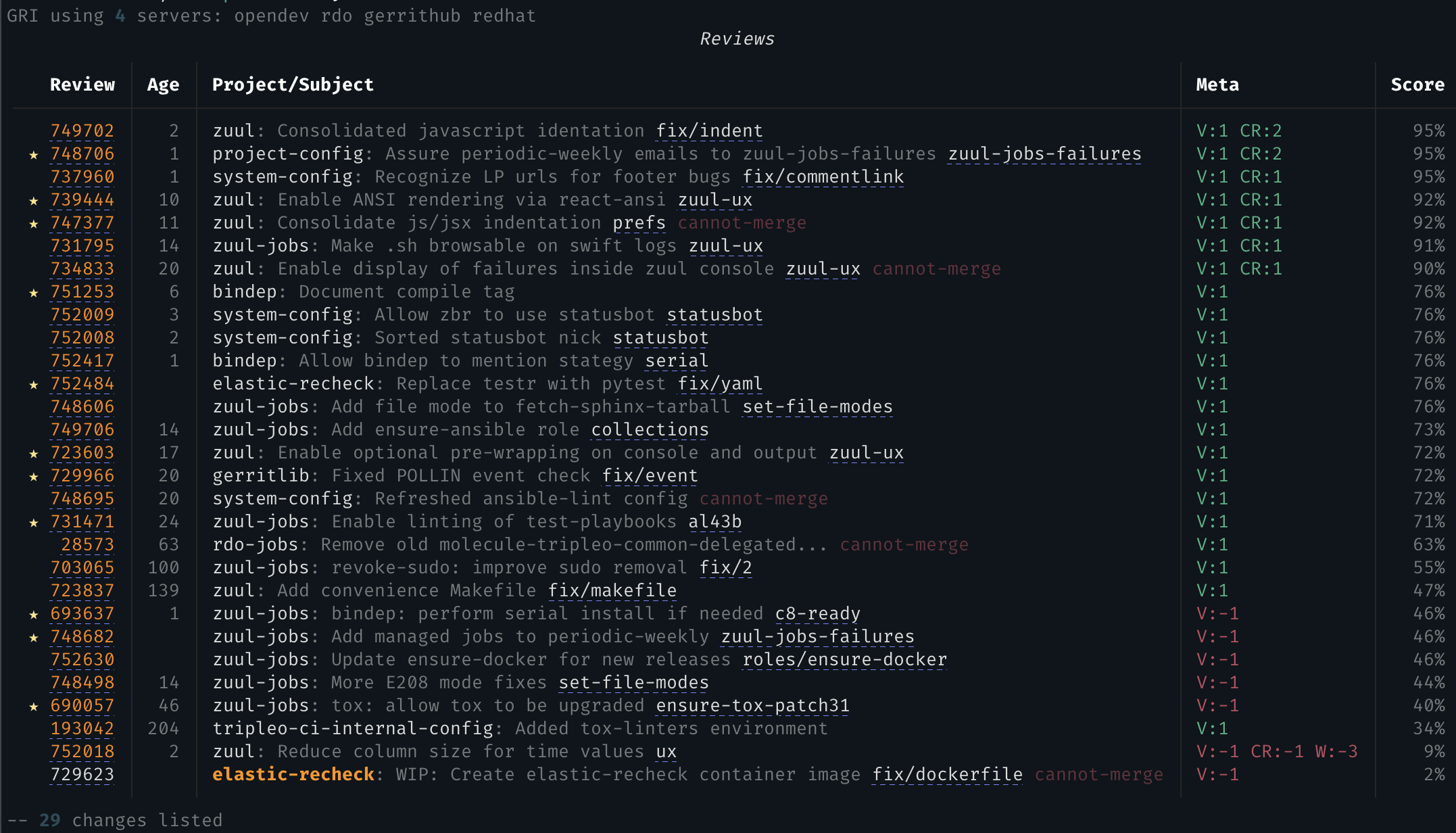Git Review Interface for Gerrit and Github
Project description
gri : Git Reduced Interface
gri is a CLI tool that lists git reviews from multiple servers
in a way that makes easier to to identify which one need you attention.
Currently supported backends are Gerrit and GitHub but it should be easy to add others if needed.
Features
- combines results from multiple Gerrit or GitHub servers
- uses terminal clickable links to make it easy to access these reviews
- displays important metadata related to reviews in a compressed format
- reviews are sorted based on probablility of getting merged
- allows user to abandon very old reviews
- can be used to query:
- already merged reviews
- incoming reviews (where you are a reviewer)
- reviewes created by other users than yourself
- produce HTML reports
Installing
pip install gri
Usage
You can just run gri, or python -m gri in order to get a list of your
current reviews, aslo known as outgoing reviews.
GRI uses a simple config file ~/.config/gri/gri.yaml but when the file
is missing, it will try to load servers from ~/.gertty.yaml in case you
have one.
$ gri --help
Usage: gri [OPTIONS] COMMAND1 [ARGS]... [COMMAND2 [ARGS]...]...
Options:
-a, --abandon Abandon changes (delete for drafts) when they are
>90 days old and with negative score. Requires -f
to perform the action.
-z, --abandon-age INTEGER default=90, number of days for which changes are
subject to abandon
-u, --user TEXT Query another user than self
-s, --server TEXT [0,1,2] key in list of servers, Query a single
server instead of all
-o, --output TEXT Filename to dump the result in, currently only
HTML is supported
-f, --force Perform potentially destructive actions.
-d, --debug Debug mode
--help Show this message and exit.
Commands:
incoming Incoming reviews (not mine)
merged merged in the last number of days
owned Changes originated from current user (implicit)
There is also an experimental grib command line for quering bugs (issues),
which has almost identical options.
Configuring
Unless you already have a GerTTY config, here is how to configure the tool:
# ~/.config/gri/gri.yaml
servers:
- name: opendev # server 0, select it with '-s 0'
url: https://review.opendev.org/
- name: rdo # server 0, select it with '-s 1'
url: https://review.rdoproject.org/r/
auth-type: basic # needed only for old gerrit versions
You may be surprised to observe that the credentials are not stored inside
the same file. That is by design and the tool will load them from ~/.netrc
file, which is also the standard way to place network related credentials.
# ~/.netrc
# password is the token generated by gerrit on your user settings page
machine review.rdoproject.org login jonhdoe password changeme
Contributing
Are you missing a feature, just check if there is a bug open for it and add a new one if not. Once done, you are welcomed to make a PR that implements the missing change.
Related tools
- git-review is the git extension for working with gerrit, where I am also one of the core contributors.
- gertty is a very useful tui for gerrit which inspired me but which presents one essential design limitation: it does not work with multiple Gerrit servers.
- gerrit-view is a vscode plugin that can be installed from Visual Studio Marketplace.
Notes
griname comes from my attempt to find a short name that was starting with g (from git/gerrit) and preferably sounds likecli.
Project details
Release history Release notifications | RSS feed
Download files
Download the file for your platform. If you're not sure which to choose, learn more about installing packages.
Source Distribution
Built Distribution
File details
Details for the file gri-0.6.1.tar.gz.
File metadata
- Download URL: gri-0.6.1.tar.gz
- Upload date:
- Size: 19.1 kB
- Tags: Source
- Uploaded using Trusted Publishing? No
- Uploaded via: twine/3.2.0 pkginfo/1.6.1 requests/2.25.0 setuptools/50.3.2 requests-toolbelt/0.9.1 tqdm/4.53.0 CPython/3.8.6
File hashes
| Algorithm | Hash digest | |
|---|---|---|
| SHA256 | 6ccec3ac9a302361d8220447f0ac95226faf498f9207bec5dc9e8fa6c5e41c10 |
|
| MD5 | 6abb1fbf5d6b59036b67693c4e84ca3c |
|
| BLAKE2b-256 | d9aec3cf36ff3c1c56a9ced94c3fdf6ae74785100dda6b2a39eed76d712ab979 |
File details
Details for the file gri-0.6.1-py3-none-any.whl.
File metadata
- Download URL: gri-0.6.1-py3-none-any.whl
- Upload date:
- Size: 17.4 kB
- Tags: Python 3
- Uploaded using Trusted Publishing? No
- Uploaded via: twine/3.2.0 pkginfo/1.6.1 requests/2.25.0 setuptools/50.3.2 requests-toolbelt/0.9.1 tqdm/4.53.0 CPython/3.8.6
File hashes
| Algorithm | Hash digest | |
|---|---|---|
| SHA256 | 21dd345321495f8f0066be3a81a9ac9fefddf92becf8ea3293547d78f6f55d76 |
|
| MD5 | 90d209f73fc2982c3a3d435ade2ef422 |
|
| BLAKE2b-256 | 50b1a71b42869d5ff099e83b20099485999f2e0a0ba1c2543ebfab62cf9842a6 |













